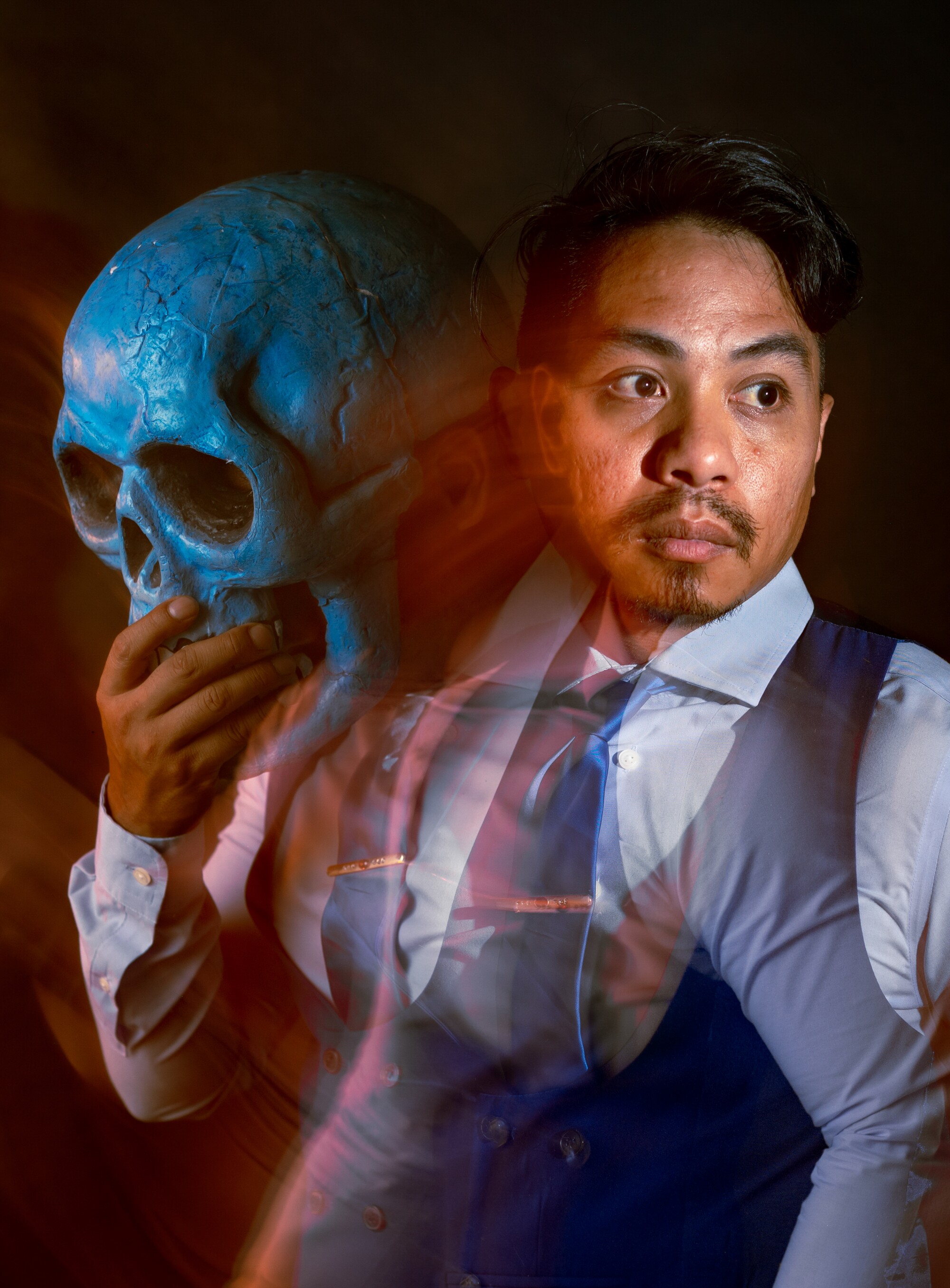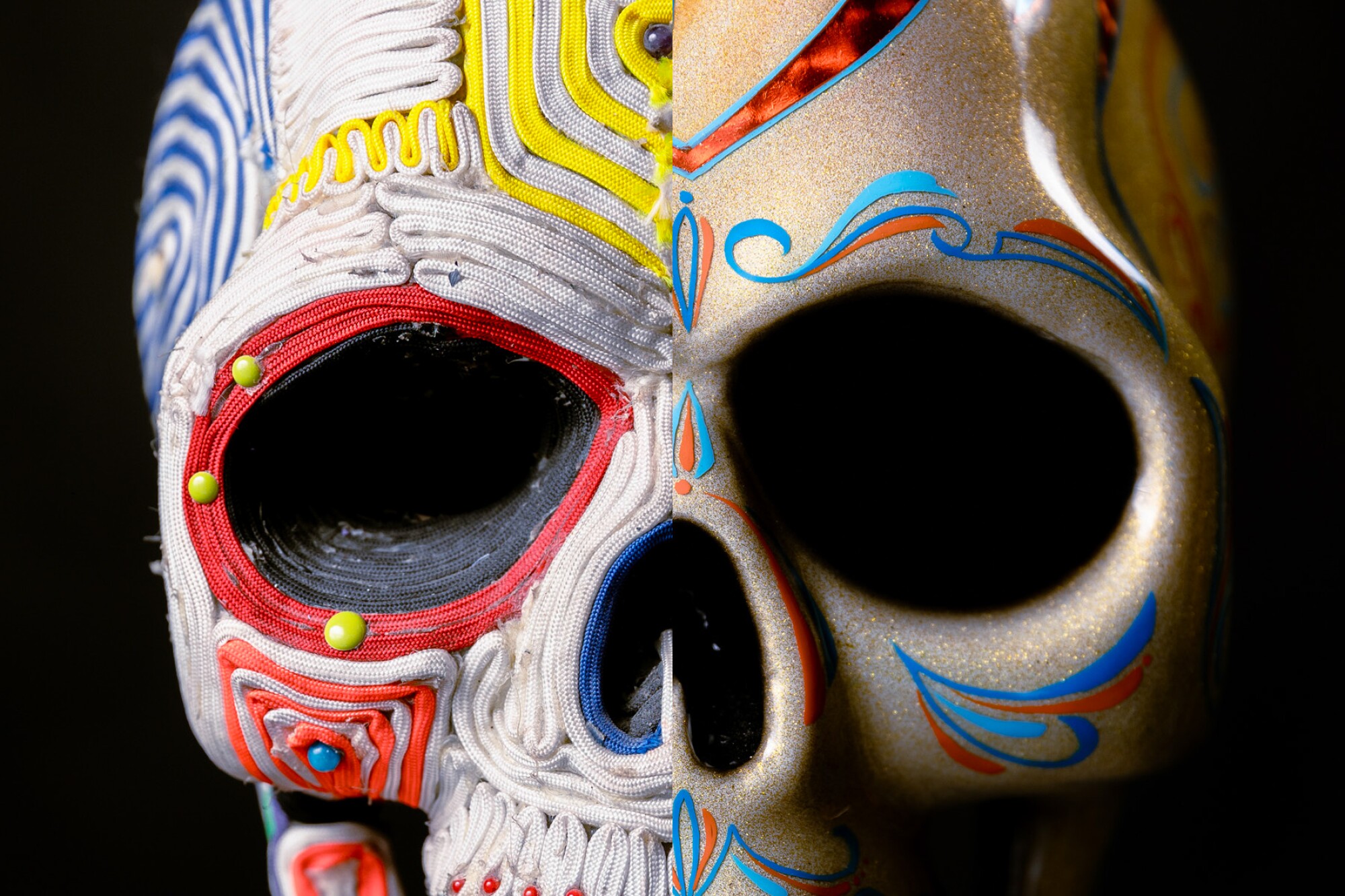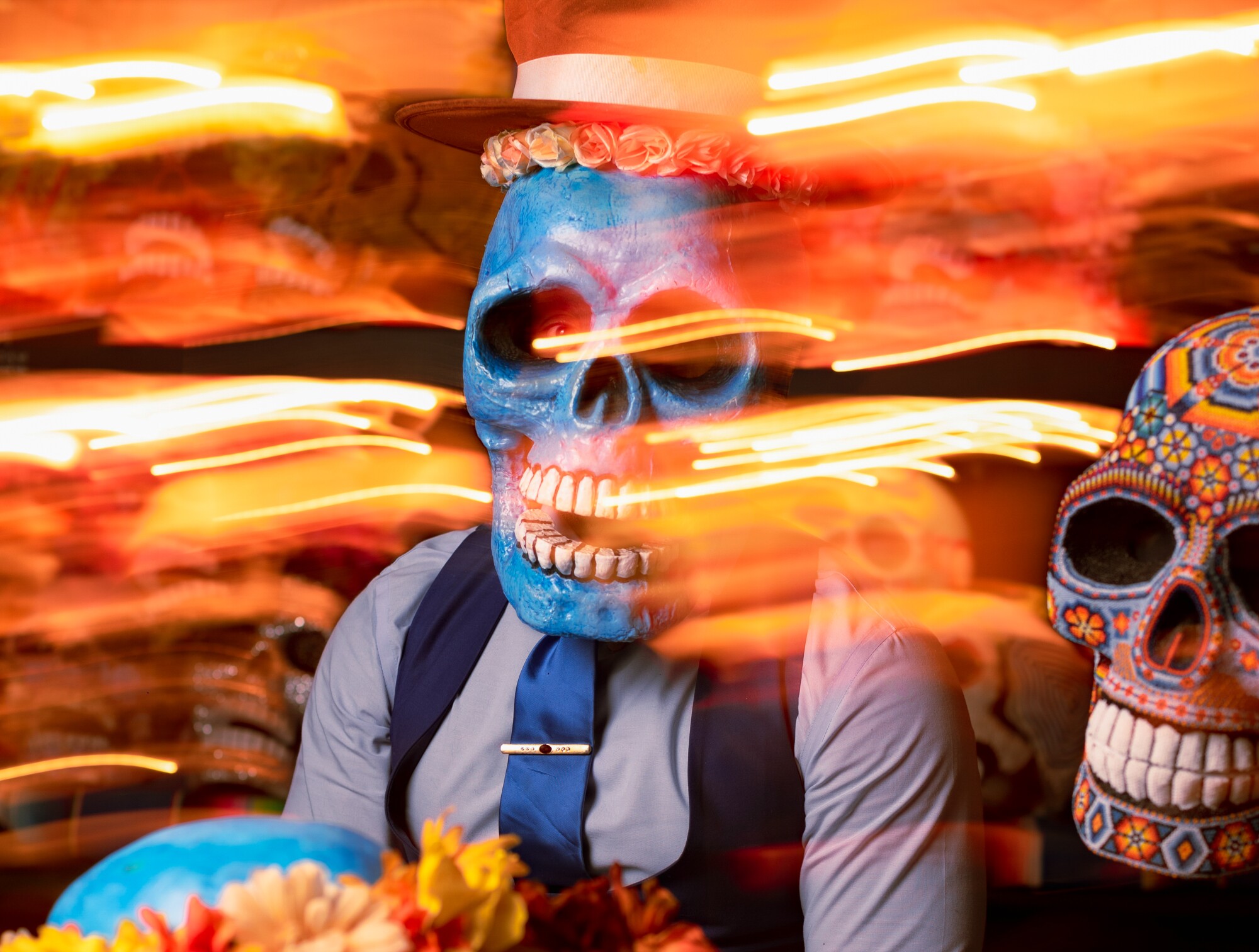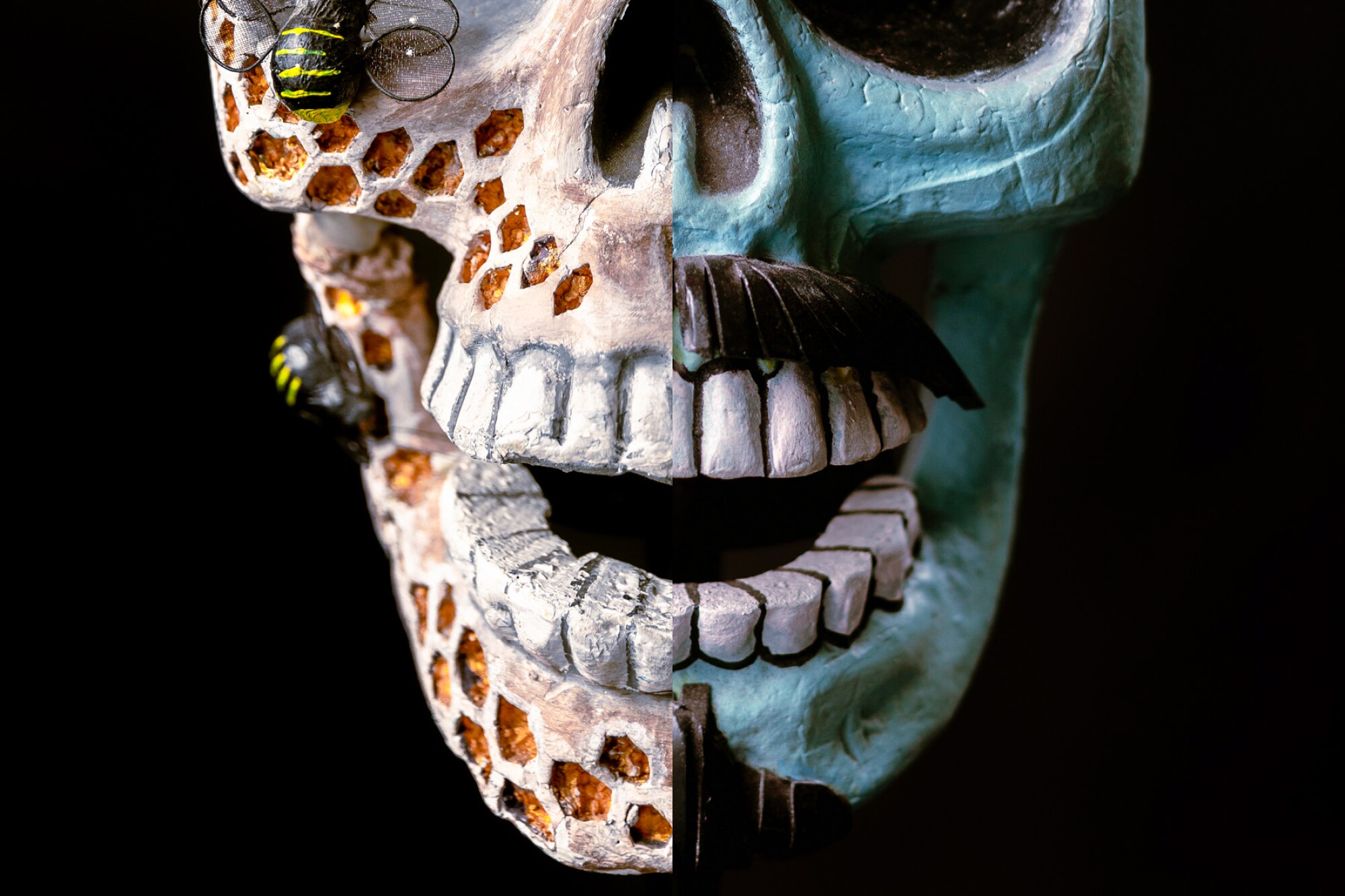Who’s the masked guy in a suit putting on mesmerizing smoke shows on L.A. streets?
Butch Locsin’s two-car garage is full of skulls. Thirty-nine skulls to be exact.
They’re not real skulls; they’re masterfully sculpted, intricately painted styrofoam masks. When he places one over his head, he transforms into his alter ego: the Skeleton of Color.

Butch Locsin holds one of his signature skull masks in his studio.
(Wesley Lapointe / Los Angeles Times)
Locsin uses the masks during his hypnotic street performances when he dresses up in vibrant three-piece suits and sets off dozens of smoke grenades, swirling clouds of color around himself. He’ll march forward in glittery, silver loafers, lunging to the ground and spinning around. When he emerges from the smoke, he looks triumphant.
The Skeleton of Color lets Locsin express himself in a way the “typical Butch” can’t. “The masks empower me,” he said. “When I put them on and all eyes are on me, it just gives me this confidence, this rush.”
Locsin has performed all around the world, from the streets of L.A. to festivals in New Zealand to parades in Mexico, since inventing the character in 2014. He’s been in commercials, movies and music videos, and garnered roughly 250,000 followers each on Instagram and TikTok.
Shooting his mysterious smoke shows in public is no small feat. Locsin needs to find spaces large enough for the smoke to rise and spread. He also needs to fit all his camera and lighting equipment without blocking passersby and traffic. He likes going late at night to the 2nd Street Tunnel, Slauson Avenue Bridge and Bay Street. He typically puts on the shows to make social media content, but sometimes he’ll post about a shoot on his Instagram story so fans can come watch in person.
Locsin developed an infatuation with skulls as a kid after seeing them graffitied on the streets of L.A. His favorite Marvel character was the Punisher, an antihero whose symbol is a skull and crossbones. So, he began to design skull masks. The colorful suits and smoke grenades followed.
“I started playing around with this character and I was getting really positive feedback,” Locsin said. “And from there it just took off.”
The Skeleton of Color is an homage to Mexican culture and the Day of the Dead, a November holiday honoring the lives of past loved ones. It’s typically observed through family gatherings or the creation of shrines — and wearing skull makeup and masks. Though Locsin is Filipino American, he appreciates the holiday and enjoys celebrating it.
On social media, Locsin’s performance videos are flooded with positive reactions, but whether his art upholds the original meaning of the holiday is still open to debate.

Twelve of Butch Locsin’s 39 masks.
(Wesley Lapointe / Los Angeles Times)
Consuelo Flores, a Day of the Dead legacy artist at Self Help Graphics, an organization committed to advancing Chicanx and Latinx artists, believes personal relationships and identity are important parts of the holiday.
“It’s very important to me that this celebration maintains its authenticity,” she said. “His work may be pretty and it may be dazzling, but I don’t think it has the substance to be an authentic representation of the celebration.”
Flores said there is a certain responsibility that comes with cultural representations in art. “It entails a level of respect and knowing what we’re doing instead of just playing with it,” she said.
However, Gabriela Rodriguez-Gomez, a Chicanx studies expert who teaches a course at UCLA on Day of the Dead visual culture, doesn’t let Locsin’s Filipino roots affect the way she views his art.
“I always say to my students, ‘First and foremost we need to acknowledge and respect the fact that these are traditions that were handed down through generations by Indigenous people,’” she said. “‘But you don’t have to be Mexican or of Mexican descent to understand or appreciate these visual cultures.’ When I view this work, I see someone who is appreciative of a very deep-rooted tradition that is not just in Mexico but also in Latin America and many other parts of the world. I’m glad he is taking this on and loving it and finding success with it.”
Rodriguez-Gomez added that it’s important for artists to give back to the cultural communities that inspire them, whether that be through financial support or raising awareness about traditions.
Locsin has made an effort to connect and collaborate with Mexican creators like Fermin La Calaca, a performer from Mexico. Like Locsin, Fermin wears painted skull masks. Unlike Locsin, he uses only his stage name and never removes the mask in public. The two have been collaborating since 2018. Last year, they starred in a commercial together for a Mexican canned goods company.
“At the end of the day, he’s not Hispanic but he represents the culture really well,” Fermin said.

Two of artist Butch Locsin’s signature skull masks in his studio, spliced into one skull image.
(Wesley Lapointe / Los Angeles Times)

Performance artist and painter Butch Locsin wears one of his signature skull masks in his studio.
(Wesley Lapointe / Los Angeles Times)

Two of artist Butch Locsin’s signature skull masks in his studio, side-by-side.
(Wesley Lapointe / Los Angeles Times)
Locsin is honored to display his art in Mexico and to have found community through the Skeleton of Color. He knows that his Day of the Dead representations only scratch the surface, but it’s because he’s set boundaries for himself.
“I know it’s best to allow it to come naturally,” he said. “Once I feel I have the correct way to showcase a deeper representation, I will dive deep. As the way things stand now and what I’m comfortable with, the character has been an entity of celebration.”
Fermin and Locsin call regularly to “ping-pong ideas really intensely.” Fermin will tell Locsin how he’s working to perfect setting his hands on fire and Locsin will explain his vision for a new mask.
“You have to understand, this is not a regular job where you work eight hours a day,” Fermin said of his and Locsin’s work. “It’s a constant thing. You’re always thinking about it.”
After graduating from a San Fernando Valley high school and going to automotive trade school, Locsin got a job at an L.A. Fitness. One day, after eight years of selling gym memberships, he quit on a whim and enrolled in community college to take painting, life drawing and photo editing classes. “A lot of my classmates had practiced art their whole lives,” Locsin said. “But my artistic renaissance came late. I had to push myself to match the standard of what I saw around me.”
His masks start as hollow, styrofoam semicircles. But after sculpting them with sandpaper, covering them in Bondo body filler (typically used to repair cars) and smoothing the imperfections with his fingers, Locsin finishes the masks in a variety of ways. He’s covered masks in fake marigolds, pearls, mirror shards and gemstones. He’s affixed hats on top, and painted others with hundreds of detailed brushstrokes. He’s glued 20,000 beads onto masks while watching “Game of Thrones.”
“With every new mask I make, I always ask myself, ‘How can I be innovative? How can I be different?’” Locsin said.
Some masks have names, like “Rojo” or “Mr. Suave.” Locsin’s favorite mask is named Malakai. A simple, seafoam-green skull, Malakai was one of the first masks Locsin created; he believes it brings him luck. He wore it during his first performance in downtown L.A., traveled with it around Europe, brought it to a Day of the Dead parade in Mexico City and used it while filming a music video for French Montana (who bought two masks for $3,500 apiece afterward). Locsin doesn’t typically sell his masks. He wants his character to be one of a kind.
Locsin’s suits are another crucial aspect of his performances. In college, he went thrifting for suit pieces at Goodwill. The clothes often fit loosely and didn’t match. Now, he gets his outfits tailor-made. The last time he counted, there were 37 suits in his closet. He rotates through them for his shoots.
“The smoke, the outfits and the masks are all coordinated based on color theory,” Locsin said. “Nothing is random. It’s all stuff I learned in my art classes.”
When he was working at L.A. Fitness, Locsin never dreamed of becoming a performance artist. Now, he brings his mask with him to the gym. He says he is more comfortable with it on than off.
“The mask makes him an amplified version of himself,” said Cesar Ramirez, one of Locsin’s close friends. “It gives him this charisma.”
Locsin’s life now revolves around the Skeleton of Color.
“This is something that I’ve dedicated myself to for the last seven years,” he said. “I want to create an image that will outlast me.”
Locsin recently flew to Mexico for the start of what he calls “Day of the Dead season,” his busiest time of year. For him, it lasts from late August until the November holiday. While in Mexico, he’ll film two commercials and tons of content for social media. He’s currently creating two new red and gold masks for the trip. A matching suit is with the tailor.
For all the latest Life Style News Click Here
For the latest news and updates, follow us on Google News.
